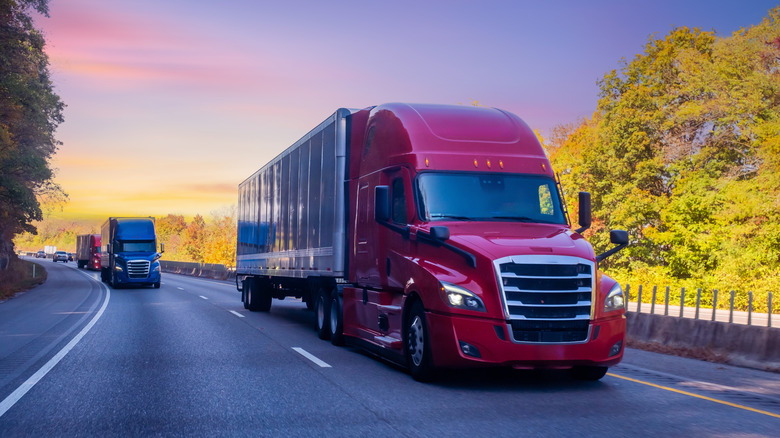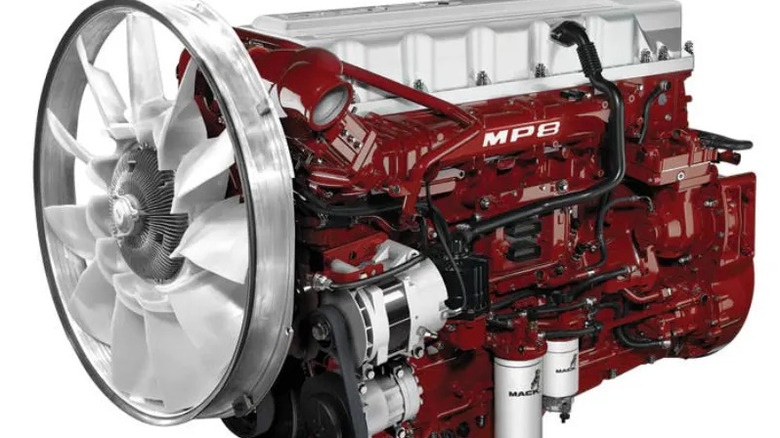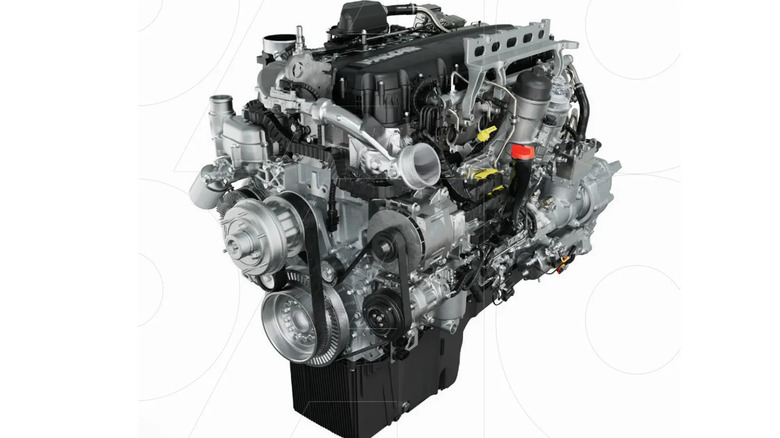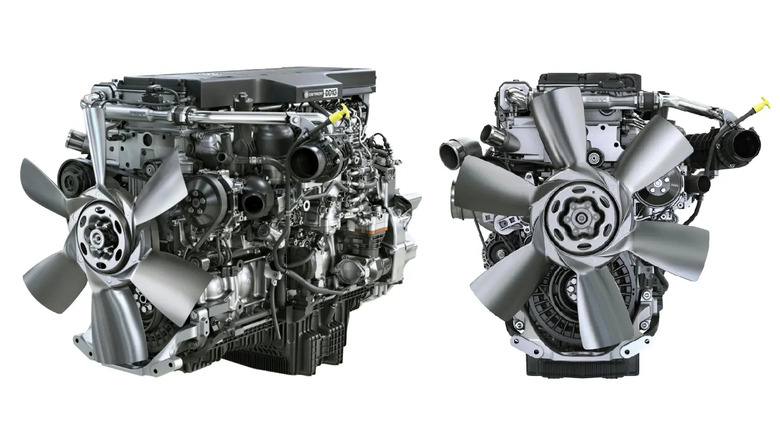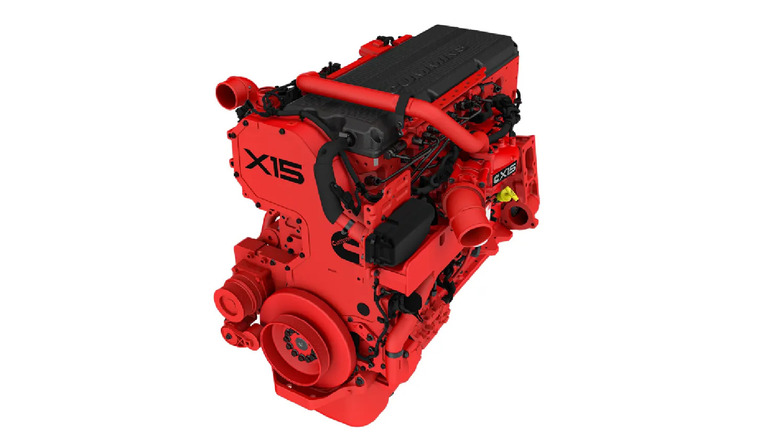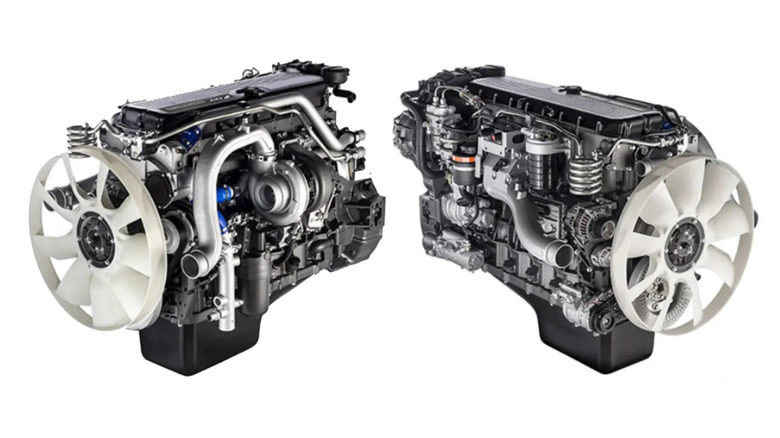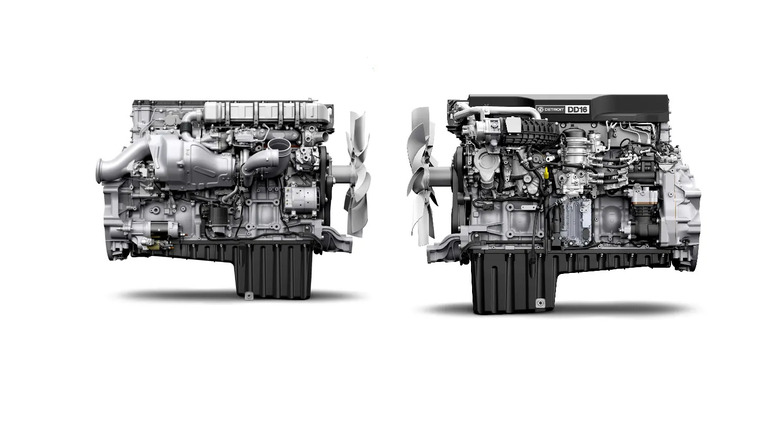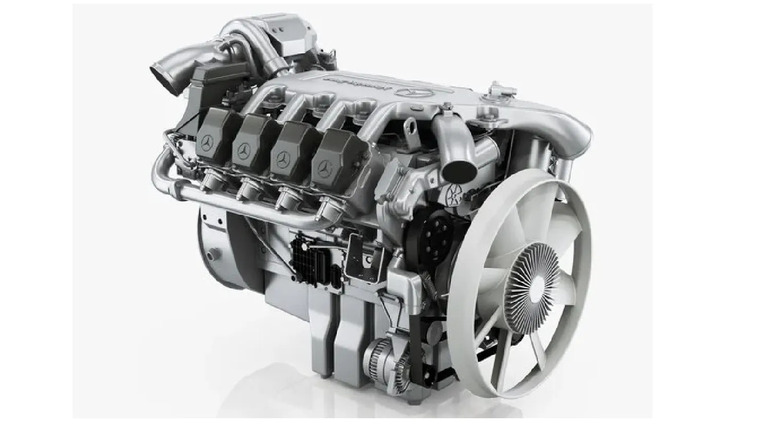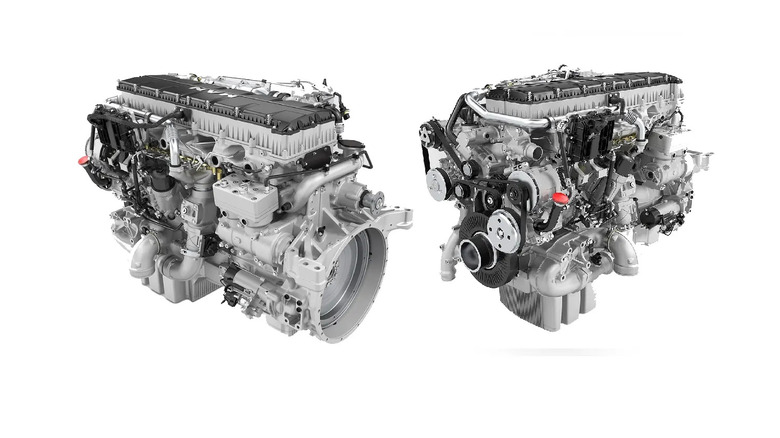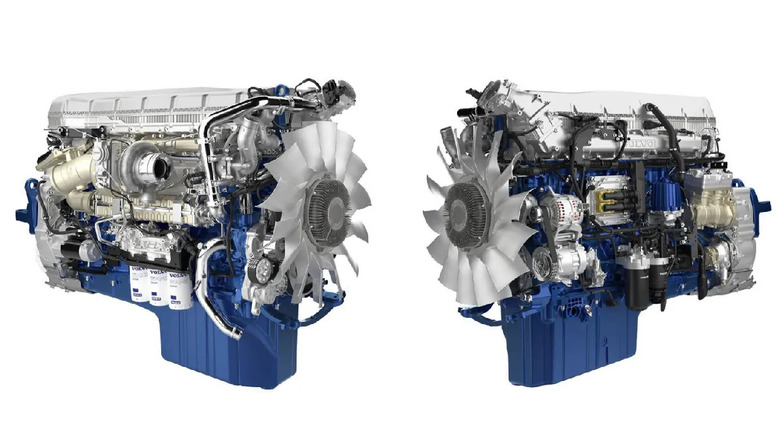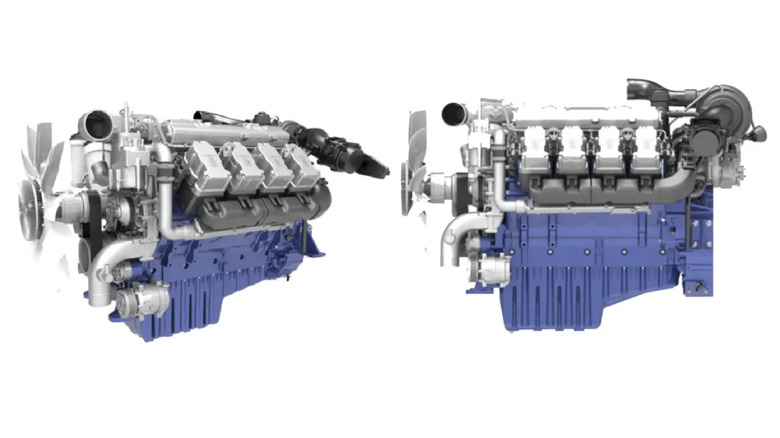10 Of The Most Powerful Diesel Engines Ever Put In Semi-Trucks
Trucks are the backbone of the modern global economy, traversing the world's longest highways. In America, semi-rigs are a familiar sight on the interstate networks, hauling tens of thousands of tons of cargo, but have you ever wondered where they get their power from?
You might be surprised to learn that there aren't that many engines that power semi-trucks, especially the larger ones. Most of them will choose a chassis from a maker like Kenworth, Peterbilt, Freightliner, or Mack and then install a diesel engine of their choice. Major engine makers include Paccar (Kenworth & Peterbilt), Volvo, Mack, Cummins, and Detroit. There really aren't any other major manufacturers who make semi-truck engines, so the names above will make up the majority, if not the entirety of this list. Also, we have included big names from Europe, Asia, and Australia, as their trucking industries almost rival ours, and they've got some amazing offerings as well.
Now, semi-trucks have two main metrics with which we judge their power — horsepower and torque. We've already ranked the 12 most powerful semi-truck engines by torque, so now we'll cover the 10 most powerful semi-truck diesel engines in terms of horsepower. Note: Sport trucks like the Volvo Iron Knight with 2400 HP are exceedingly cool, but for our article, the engines have to be stock, production variants with no aftermarket tuning or modules.
Mack MP8 -- 505 HP
Let's start with the old faithful workhorse, the Mack MP8. Even though it is the least powerful engine on our list, it still makes a very respectable 505 horsepower, and churns out 1,860 lb-ft of torque to boot. The MP8 engine can be optioned on every single heavy duty Mack branded truck, from day cab and sleeper semi-trucks to garbage rigs and specialist construction units. One other engine that competes with the Mack MP8 is the DD15 from Detroit Diesel engines, which also makes exactly 505 horsepower, but less torque, at 1,850 lb-ft. Mack, who recently made changes to their fan-favorite bulldog hood ornament, say that the newest generation MP 8s are 88 pounds lighter, and consequently, have 5% better MPG when running in automatic mode. In addition, to comply with the ever-more-stringent EPA laws, Mack has made some changes to their diesel exhaust fluid (DEF) aftertreatment system (AT).
One of the main updates to the DEF has major implications for cold-weather operators. DEF is about two-thirds water by volume, and water freezes up and clogs the system in cold weather. The aftertreatment system in the Mack MP8 solves this issue by moving all the DEF back into the tanks once you turn the engine off, which keeps the system lines clear, and the DEF can freeze in its tank without disrupting anything else.
Paccar MX-13 -- 510 HP
The MX-13 is built by Paccar for the sister brands Kenworth and Peterbilt, and will be found in iconic semi-trucks like the T680, 880, and W990 from Kenworth, and also in the 567, 579, and 589 from Peterbilt. For years, Kenworth and Peterbilt trucks have offered the Cummins X15 diesel engine, but a while ago, Paccar began making the MX-13 and mating it to the Peterbilt and Kenworth lineups. Since then, the MX-13 has been the standard option on all the Peterbilt and Kenworth heavy-haulers, though it's worth noting that the many trucks still use the Cummins X15 engine, which is available as an optional upgrade. The MX-13 comes with 1,850 lb of maximum torque — the same as the Detroit DD15 — and makes 510 brake horsepower from a 12.9-liter displacement inline-six cylinder engine.
Paccar has said that all new MX-13 engine units that are manufactured will now be compliant with the stricter EURO 6 emissions standard, and will come with a new catalytic converter system. In addition to that, the MX-13 now has an upgraded soot filtration system as standard across the range, and will limit how often recirculated exhaust gas will be released from the engine.
Detroit DD13 -- 525 HP
Next up is the 12.8-liter DD13 straight-six engine that somehow manages to put out 1,850 lb-ft of torque and up to 525 peak horsepower. You'll find this engine on rigs like the fourth and fifth-generation Freightliner Cascadia, and the Western Star 47, 49, and 57-series semi-trucks. It is a class eight diesel engine with a fixed-geometry turbocharger, and has been significantly redesigned for the latest generation with additions like swirl pistons, front-and-rear engine power takeoff (FEPTO & REPTO), and a new aftertreatment system. It also gets a new 10-pin injector system that is capable of asymmetric injection, which in turn reduces regeneration cycles on the engine, greatly increasing the DD13's durability. All of these changes supposedly bring about an MPG improvement of about 4%, Detroit claims, though real-world data isn't in yet.
Depending on your needs, you should be able to configure your DD13 to be EPA, CARB, OBD, and/ or GHG compliant; though if you're looking at the M2 112 plus from Freightliner, you won't be able to spec a CARB-compliant DD13. And, as expected the DD13 comes with all the usual bells and whistles you'd expect on a top-notch engine, such as Detroit Connect, the Detroit Virtual Technician, and over-the-air (OTA) software updates. A nice talking point that we should highlight is that the Detroit DD13 has the longest service intervals in its class, at 35,000 miles for the engine oil and fuel filter, and 100,000 miles for the first valve lash adjustment, then every 500,000 miles after.
Cummins X15 -- 565 HP
Arguably the most legendary engine on this list, the X15 diesel engine from Cummins makes a solid 565 horsepower, and a whopping 2,050 lb-ft of torque from a 14.8-liter inline-six unit. Interestingly enough, this is not the largest engine that Cummins makes, seeing as how Cummins also make train engines, but is certainly the company's biggest truck engine. The X15 is EPA 2024 certified and meets Greenhouse Gas Phase II requirements. Cummins has also used more than a million miles of testing data, and has come up with a system that predicts the remaining life of all the consumable items on the X15, like the fuel filter, urea filter, diesel particulate filters (DPFs), oil filters, and even the oil itself.
All X15 engines will also get access to Cummins' Connected Solutions (CCS), which is a proprietary software that assists with over the air (OTA) software upgrading and remote diagnostics. In addition, all X15 engines are programmed to work with Guidanz, which is Cummins' servicing technology package. You'll find the Cummins X15 in trucks like the LT and HX lines from International, the Cascadia lineup from Freightliner, and of course, the big haulers from Peterbilt and Kenworth like the 589 and T880. Given that all of these are best-selling models, chances are that the big rigs you see on the highway are being powered by a Cummins unit.
Cursor 13 -- 570 HP
Now for our first non-American engine, the Cursor 13, which has been developed by FPT industrial, which itself is a subsidiary of the huge IVECO group. IVECO makes the Cursor 13 in several variants, including one for heavy trucks. As of 2025, the Cursor 13 truck engine is offered in six different power levels, starting from 302 kW (405 horsepower) and 1,564 lb-ft of maximum torque. The most powerful Cursor 13 variant is approximately 50% more powerful, as it can make up to 600 horsepower and 1,770 lb-ft of torque, and was designed to power trucks 16 tons gross vehicle weight (GVW) and over.
The lower-powered engine variants use a wastegate turbocharger, but the 600 horsepower variant uses an electronically-controlled variable geometry (eVGT) turbocharger. All variants of the Cursor 13 have a dry weight of 1,132 kilograms (2,496 pounds) and use common-rail injection systems. Finally, all Cursor 13 engines come with the same aftertreatment system, consisting of a diesel oxidation catalyst (DOC), diesel particulate filter (DPF), selective catalytic reduction (SCR), and a clean-up catalyst (CUC).
Detroit DD16 -- 600 HP
One of the most popular engines on the market is the 15.6-liter inline-six DD16 from Detroit, making 600 horsepower and 2,050 lb-ft of torque. You'll find the DD16 being used in the 49XX and 57XX rigs from Western Star, and in the latest-generation Cascadias from Freightliner. The DD16 is by far the most powerful and technologically advanced engine that Detroit makes, and impressively, continues to meet new emissions regulations. The fuel injectors on the DD16 have a standard operating pressure of 38,000 PSI, thanks to a new amplified common rail injection system (ACRS), which leads to more efficient and cleaner combustion overall. On top of that, the DD16 has a unique compound turbocharger layout, using a turbo for the main engine boost and a secondary exhaust turbine.
The exhaust turbine unit supposedly catches heat and other exhaust gases that would not have been utilized otherwise, and uses them to spin its blades, providing a little bit more power and grunt to the system. It makes sense — the aftertreatment system is going to recirculate the exhaust gases a few times anyway, so might as well get a little more power out of it. You also get three levels of engine braking on the DD16, courtesy of what Detroit calls their "Jacobs" brake.
Mercedes OM 502 LA -- 612 HP
If you've seen a Mercedes semi-truck, it's probably been an Actros; and if you've seen an Actros, it's probably been paired with the OM 502 or OM 501 engine from Mercedes. The OM 501 makes less power (435 horsepower) than the OM 502, which is currently the top-of-the-line offering from Mercedes Trucks. The 502 LA, which is the larger of the two Actros engines, makes 450 kW (612 horsepower) and 2,700 Nm (1,991 lb-ft) of torque from a 15.9-liter V8 block that is paired to either a 12 or 16-speed G-series PowerShift transmission, also from Mercedes. Together, this pairing can offer lots of great features to European truckers, like higher-speed reversing, extended cruise control settings from 2 kmph (1.25 mph) upwards, a rock-free mode for traversing rough terrain, and a direct shift from first gear to reverse gear that bypasses going into neutral.
In addition, most 502 engines will also be Euro emissions standard compliant, with all engine systems being controlled by an engine management system (EMS) called "Telligent". Another standout feature on the 502 LA from Mercedes is that, just like the DD16, recirculated exhaust air is used to generate extra power for the engine to use under heavy loads. The only difference between the DD16 and OM 502 LA systems is that Mercedes uses not one, but two exhaust gas turbochargers and a unit pump system (UPS). It's nice to see Mercedes keeping this engine alive, as it allows for flat-front nose semi-trucks, which have all but disappeared in America — and who knows if these good-looking rigs will ever be back.
MAN TGX D38 -- 660 HP
MAN trucks are mainly sold in Europe, and are manufactured in Germany, because MAN is a subsidiary of the Volkswagen group, which owns plenty of other brands as well. It only makes sense then, that the biggest MAN trucks like the TGX line, will be powered by the most powerful MAN engine, which is the D38. Technically, the full name for this engine is the — get ready — MAN D3876 LE12x, but the industry calls it the D38 for simplicity. It is offered in three main variants: 565 horsepower, 612 horsepower, and 660 horsepower, with corresponding torque variations as well. The displacement for all variants is on the higher side by European standards, at 15.26 liters overall, producing a mind-bending 3,000 Nm (2,213 lb-ft) of torque, by operating at 2,500 bar (36,260 PSI). The engine is fully compliant with the latest US EPA and/ or CARB regulations, and was unveiled at IAA Nutzfahrzeuge in Germany.
Weighing in at 1,337 kg (2,948 pounds), the MAN D38 is not exactly light, but it more than makes up for that shortcoming by having low servicing costs, commonly available OEM parts, a bulletproof variable-geometry turbocharger, reused component groups with other MAN engines, and ability to pull up to 120 tons, which is significantly more than its U.S. counterparts, which are federally capped at 80,000 lbs on highways. That in itself is a feat to beat, for even if the DOT allowed us to haul longer loads, there's no guarantee of how engines from Mack, Paccar, or Cummins would hold up. The MAN D38 however, positively shines.
Volvo D17 -- 780 HP
The Volvo D17 is the latest engine from Volvo trucks, and is actually the highest-displacement unit on our list, coming in at 17.3-liters, making 780 brake horsepower and a claimed 2,803 lb-ft of torque. The engine has not been released for Volvo's home market of Europe yet, but has been undergoing road tests in Australia since early this year. If we had to guest, these are test-rigs collecting usage data for the D17 engine, most of which will power the FH-series of ultra-long haulers from Volvo. The D17 is intended to be a step-up from the current top-range engine from Volvo Trucks, which is the 500 horsepower, 1,650 lb-ft D13 truck engine. A major feature of the D17 is that you'll be able to choose from among three fuels, which are diesel, the newly introduced renewable fuel called HVO, and a future version will also work on 100% B100 biodiesel.
Weichai WP17H -- 800 HP
The Weichai WP17H is the most powerful diesel engine ever put in a production truck. Used in the Shacman X6000, it produces 800 horsepower and 2,766 lb-ft of peak torque. This configuration is widely regarded to be the most powerful production truck in the world, though it is not clear whether Weichai or Shacman intend to expand on the lineup. A standout talking point about the Weichai WP17H engine is that it is rated for a service life of two million kilometers (about 1.24 million miles) of continuous operation.
Currently, the Weichai-powered Shacman is produced and used in China, but is also sold in Russia and there are potential expansion plans eyeing up Argentina and the rest of Latin America. Coming back to the monstrous Weichai WP17H engine though, the truck variant is a 16.6- liter four-stroke V8 unit, definitely among the biggest V-8s in the world, and has multiple other configurations, including specialized ones for cranes, agriculture, mining, and construction. There's really not much more to be said about the WP17H — it's big, powerful, torquey, and we can only hope that one day, Paccar, Mack, Cummins, or Detroit gives us something to match.
And that's it — the 10 most powerful diesel engines that ever powered a semi-truck. From flatbed trailers to specialized rigs, these are the engines that keep heavy industry around the world moving, and now you've got an interesting conversation starter at the next family dinner.
